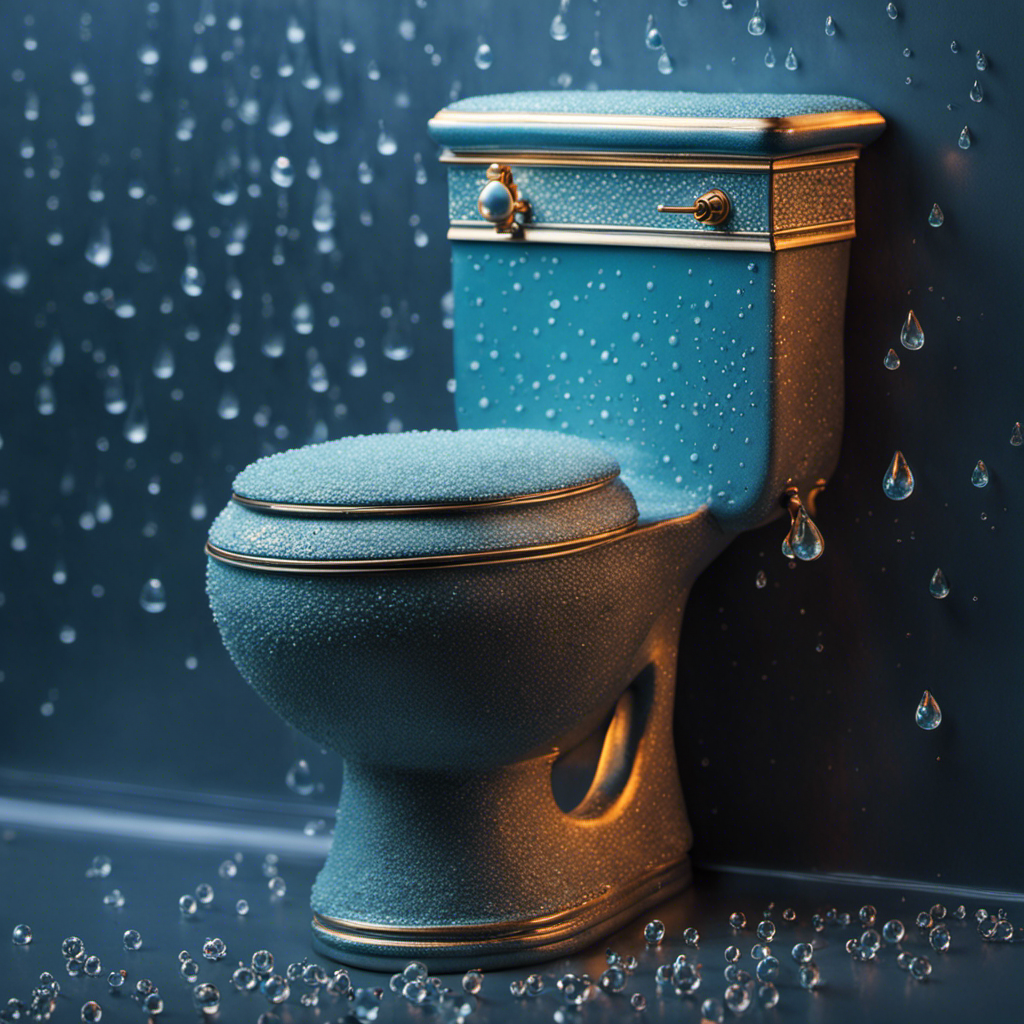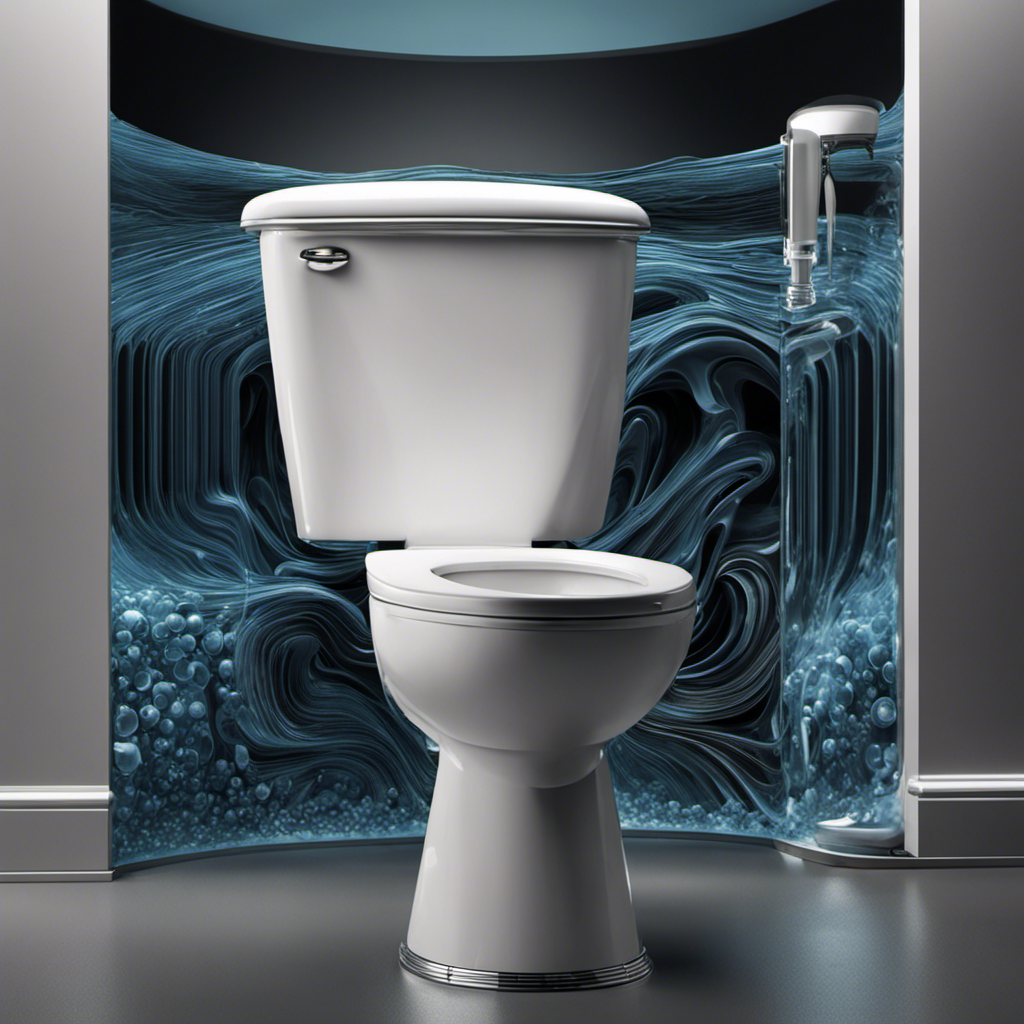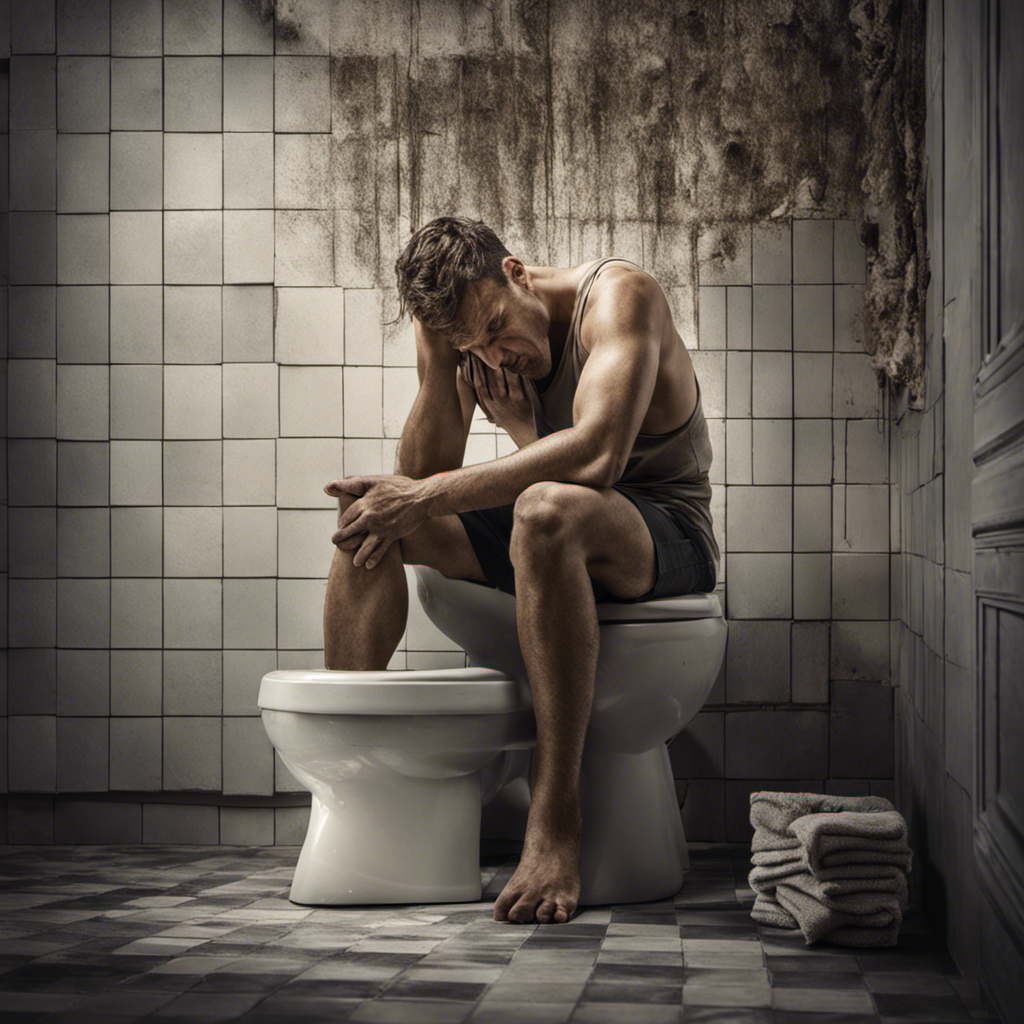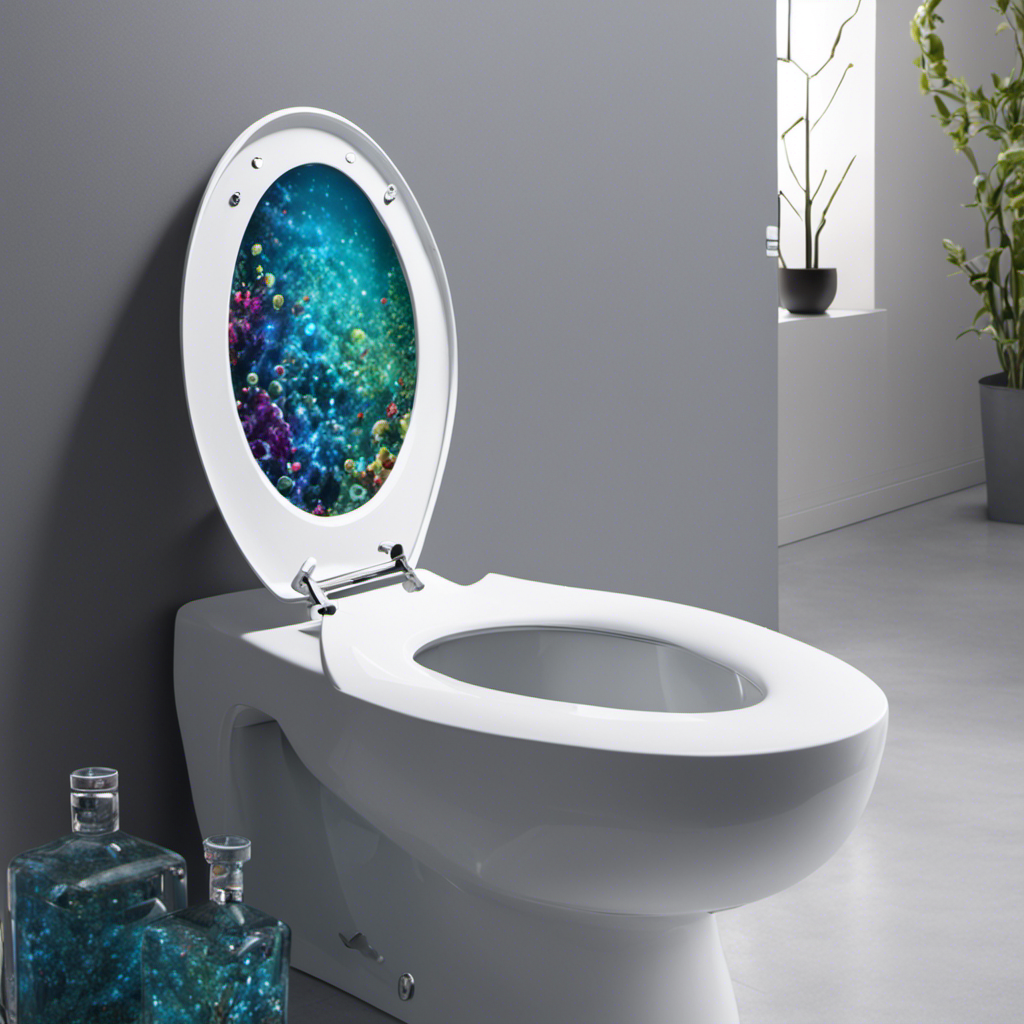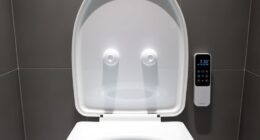As I sit down on the cold porcelain seat, I can’t help but notice the beads of water forming on the surface of my toilet. It’s like the toilet is sweating, just like I do after a workout.
But why does this happen? In this article, we will explore the common causes of toilet sweating, understand condensation on toilets, and delve into the impact of humidity.
With some helpful tips and insights, we’ll also discuss how to prevent this pesky issue from occurring.
Key Takeaways
- Toilet sweating is caused by temperature differences between the water inside the tank and the air in the bathroom.
- Condensation occurs when warm, humid air comes into contact with a cold surface, such as the toilet tank.
- Higher humidity levels lead to more condensation on the toilet, while lower humidity levels reduce condensation and minimize toilet sweating.
- Proper ventilation is crucial in preventing toilet sweating by removing excess moisture and promoting balanced moisture levels in the bathroom.
Common Causes of Toilet Sweating
One common cause of your toilet sweating is when the temperature difference between the water inside the tank and the air in the bathroom is significant. Understanding condensation issues is crucial in effectively preventing this problem.
When the air in the bathroom is warmer and more humid than the water in the toilet tank, condensation occurs. This happens because the cold water inside the tank cools the air around it, causing the moisture in the air to condense on the surface of the tank.
To prevent toilet sweating, there are several effective methods you can employ. First, you can insulate the tank by using a tank liner or foam insulation. This helps to maintain the water temperature and reduce the temperature difference.
Additionally, you can use a dehumidifier in the bathroom to lower the humidity levels. Finally, ensuring proper ventilation in the bathroom by using exhaust fans can also help to prevent condensation and reduce toilet sweating.
Understanding Condensation on Toilets
To prevent condensation on your toilet, try using a toilet tank liner. Condensation occurs when warm, humid air comes into contact with a cold surface, causing water droplets to form. This is a common issue in bathrooms, especially during colder months.
Toilet sweating is directly influenced by temperature changes in the room. When the temperature of the air around the toilet drops, the cold porcelain surface causes the warm air to cool down and release moisture.
Installing a toilet tank liner can help insulate the tank, reducing the temperature difference between the air and the toilet surface. This, in turn, minimizes the chances of condensation forming.
Now, let’s explore how humidity affects toilet sweating.
How Humidity Affects Toilet Sweating
Humidity directly impacts the amount of condensation that forms on a toilet. When the air is humid, it contains a higher level of moisture, which can lead to toilet sweating. To better understand this relationship, let’s take a look at the table below:
| Humidity Level | Condensation on Toilet |
|---|---|
| High | More |
| Moderate | Some |
| Low | Less |
As the humidity level increases, so does the amount of condensation on the toilet. This happens because warm air carries more moisture, and when it comes into contact with a cooler surface like a toilet, it cools down and releases the moisture as condensation. To prevent toilet sweating, humidity control and moisture prevention are crucial. By reducing the humidity levels in your bathroom, either through proper ventilation or using a dehumidifier, you can minimize condensation and prevent toilet sweating.
Now that we understand how humidity affects toilet sweating, let’s move on to some tips to prevent this issue.
Tips to Prevent Toilet Sweating
Toilet sweating can be a frustrating problem to deal with, but understanding the causes can help in finding effective prevention methods.
One common cause of toilet sweating is the difference in temperature between the water inside the toilet bowl and the air in the bathroom. This temperature difference leads to condensation forming on the outside of the toilet bowl, resulting in the unpleasant sweating phenomenon.
However, there are preventive measures that can be taken, such as installing an anti-sweat valve or using insulation materials, to help regulate the temperature and minimize toilet sweating.
Causes of Toilet Sweating
Excessive condensation on the toilet bowl can be caused by temperature differences in the bathroom. Understanding condensation and finding ventilation solutions are crucial in addressing this issue.
- Condensation occurs when warm air meets a cold surface, causing moisture to form.
- Temperature variations in the bathroom can create a prime environment for condensation to occur.
- High humidity levels can exacerbate the problem, making the toilet bowl sweat even more.
- Inadequate ventilation can trap the moist air, leading to condensation buildup.
To prevent toilet sweating, consider the following ventilation solutions:
- Increase airflow in the bathroom by installing an exhaust fan or opening windows.
- Use a dehumidifier to reduce humidity levels in the space.
- Insulate the bathroom walls and floors to minimize temperature differences.
Prevention Methods Explained
To effectively prevent condensation buildup in your bathroom, you can implement proper ventilation solutions. This includes increasing airflow and using a dehumidifier.
Condensation occurs when warm, moist air comes into contact with a cold surface, causing water droplets to form. By increasing airflow, you can reduce the amount of moisture in the air, making it less likely for condensation to occur. This can be done by installing a ventilation fan or opening windows to promote air circulation.
Additionally, using a dehumidifier can help control humidity levels in the bathroom. These devices work by removing excess moisture from the air, preventing condensation buildup.
It is important to address condensation issues promptly to prevent mold and mildew growth, as well as potential damage to your bathroom fixtures and surfaces.
The Role of Ventilation in Toilet Sweating
Improper ventilation can contribute to the sweating of your toilet. When there is inadequate air circulation in the bathroom, excess moisture can build up, leading to condensation on the toilet tank and bowl. This can be a frustrating issue to deal with, but understanding the importance of ventilation and the impact of air circulation can help prevent toilet sweating.
Here are three key points to consider:
-
Ventilation importance:
- Proper ventilation helps remove excess moisture from the bathroom.
- It allows fresh air to enter and stale air to exit, promoting a healthier environment.
- Ventilation prevents the accumulation of humidity, reducing the chances of toilet sweating.
-
Impact of air circulation:
- Good air circulation helps distribute heat evenly throughout the bathroom.
- It prevents the formation of stagnant pockets of air, which can contribute to condensation.
- Adequate air movement helps maintain a balanced moisture level, minimizing toilet sweating.
Exploring Insulation Solutions for Toilet Sweating
When it comes to addressing toilet sweating, it is essential to understand the causes, effectiveness of insulation, and methods to prevent condensation buildup.
The causes of toilet sweat can range from high humidity levels in the bathroom to temperature differences between the toilet tank and the surrounding environment.
Insulation plays a crucial role in reducing the temperature difference and preventing the formation of condensation.
Causes of Toilet Sweat
One common cause of toilet sweat is high humidity in the bathroom. When warm air comes into contact with the cold surface of the toilet bowl, condensation occurs, leading to the formation of water droplets. Understanding condensation on toilets is crucial in preventing this issue.
Here are some tips to prevent toilet sweating:
-
Increase ventilation in the bathroom:
-
Install an exhaust fan to remove excess moisture from the air.
-
Open windows or doors to allow fresh air circulation.
-
Insulate the toilet tank:
-
Use an insulated toilet tank liner to keep the water temperature stable.
-
Apply foam insulation to the exterior of the tank to reduce condensation.
-
Control room humidity:
-
Use a dehumidifier to maintain optimal humidity levels.
-
Avoid placing wet items near the toilet area.
Insulation Effectiveness
To maximize the effectiveness of insulation in preventing condensation, make sure to properly insulate both the toilet tank and the exterior of the tank. Insulation helps control moisture and prevents the formation of sweat on the toilet. There are various insulation types available, each with its own advantages and disadvantages. The choice of insulation depends on factors such as cost, availability, and ease of installation. Some commonly used insulation types for toilets include foam insulation, fiberglass insulation, and reflective insulation.
| Insulation Type | Advantages | Disadvantages |
|---|---|---|
| Foam Insulation | Easy to install | Can be expensive |
| Fiberglass Insulation | Good thermal insulation | Can irritate skin |
| Reflective Insulation | Effective in reflecting heat | Limited moisture control |
Properly insulating your toilet tank and exterior can significantly reduce condensation and prevent toilet sweat. This not only helps maintain a dry and comfortable bathroom environment but also prevents potential damage to your bathroom fixtures and flooring.
Preventing Condensation Buildup
Make sure you insulate your toilet tank and exterior properly to prevent condensation buildup and potential damage to your bathroom.
Condensation occurs when warm moist air comes into contact with a cold surface, causing the moisture in the air to condense into water droplets.
To prevent condensation buildup and moisture-related issues in your bathroom, follow these steps:
-
Insulate the inside of the toilet tank using a foam insulation kit. This will help keep the water inside the tank at a consistent temperature, reducing the temperature difference between the water and the surrounding air.
-
Install an insulated toilet tank liner to further prevent condensation. These liners act as a barrier between the cold tank and the warm air, reducing the likelihood of condensation forming.
-
Use a dehumidifier or ventilation fan in your bathroom to control the humidity levels. This will help remove excess moisture from the air, reducing the chances of condensation occurring.
Dealing With Persistent Toilet Sweating Issues
Have you tried insulating the tank of your toilet to address the persistent sweating issue? If your toilet continues to sweat even after taking preventive measures, it could be a sign of an underlying plumbing problem that needs to be fixed. Dealing with toilet leaks and fixing plumbing problems requires a thorough understanding of the various components involved. To help you troubleshoot the issue, here is a table outlining common toilet sweating causes and possible solutions:
| Cause | Solution |
|---|---|
| High humidity in the bathroom | Improve ventilation or use a dehumidifier |
| Cold water temperature | Insulate the water supply line |
| Faulty toilet tank insulation | Install an insulation kit or foam |
| Faulty fill valve | Replace the fill valve |
| Excessive water pressure | Install a pressure reducing valve |
Frequently Asked Questions
Are There Any Health Risks Associated With Toilet Sweating?
Toilet sweating can be caused by temperature differences between the bathroom and the toilet tank. This can lead to condensation, which can create a moist environment. While there are no direct health risks, it’s important to address the issue to prevent potential mold or mildew growth.
Can Toilet Sweating Lead to Mold or Mildew Growth?
Toilet sweating can lead to mold and mildew growth if not managed properly. To prevent this, ensure proper ventilation in the bathroom, use a dehumidifier if necessary, and insulate the toilet tank to reduce condensation.
How Does Toilet Sweating Affect Water Consumption?
Toilet sweating can increase water consumption by up to 200 gallons per year. Implementing toilet sweating prevention techniques, such as insulating the tank, can improve energy efficiency and reduce water waste.
Can Toilet Sweating Cause Damage to the Bathroom Flooring or Walls?
Toilet sweating can potentially cause damage to bathroom flooring and walls if not addressed. Prevention and maintenance techniques, such as reducing humidity levels and insulating the tank, can help to minimize and control toilet condensation.
Is Toilet Sweating More Common in Certain Geographical Areas?
Toilet sweating can be influenced by geographical factors and climate, making it more common in certain areas. Understanding these influences is crucial in preventing and addressing this issue effectively.
Conclusion
To conclude, understanding the causes of toilet sweating is crucial in preventing this unsightly and potentially damaging issue. By addressing factors such as humidity, ventilation, and insulation, you can effectively combat toilet sweating.
Remember, a well-ventilated and properly insulated bathroom is like a breath of fresh air for your toilet. So, don’t let your toilet sweat like a marathon runner; take action and keep it cool, dry, and happy!
